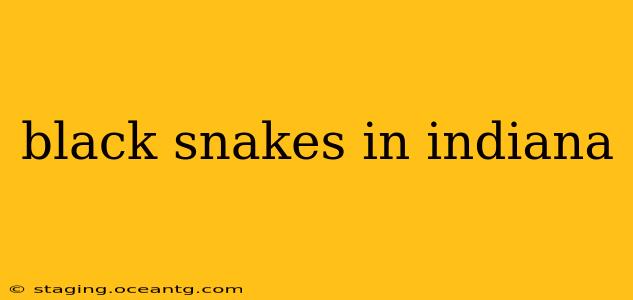Indiana is home to several species of snakes, and several are often called "black snakes" due to their dark coloration. While no snake in Indiana is entirely black, several species have predominantly dark bodies and can easily be mistaken for one another. This guide will help you identify common "black snakes" found in Indiana and understand their behavior and habitat. Understanding these snakes is crucial for ensuring safe coexistence and appreciating the vital role they play in the ecosystem.
What Kinds of Black Snakes Live in Indiana?
Several snake species in Indiana are frequently described as "black snakes" due to their dark coloring. The most common are:
-
Black Rat Snake ( Pantherophis obsoletus): This is probably the snake most people envision when they hear "black snake." While they can be various shades of gray, brown, and even black, many adults exhibit a mostly dark coloration, especially the Eastern subspecies found in Indiana. They're large, powerful constrictors known for their ability to climb trees and their preference for rodent-rich environments.
-
Eastern Hog-nosed Snake (Heterodon platirhinos): While not consistently black, some Eastern Hog-nosed snakes have dark brown or even black coloration. Their distinctive upturned snout and impressive bluff-and-sputter defense mechanisms make them readily identifiable. These snakes are not venomous, preferring to feign death rather than bite. They feed primarily on toads and other amphibians.
-
Western Hog-nosed Snake (Heterodon nasicus): Similar to their eastern cousins, some individuals can display very dark coloration, sometimes approaching black. Their upturned snout and defensive behaviors are just as dramatic as the Eastern Hog-nosed snake.
-
Other Dark-Colored Species: While less frequently referred to as "black snakes," other Indiana snakes, like the racer (various subspecies) and even some darker-colored milk snakes, can exhibit dark coloration and might be mistaken for black snakes.
Are Black Snakes in Indiana Poisonous?
No, none of the snakes commonly called "black snakes" in Indiana are venomous. They are non-venomous constrictors or bluffers that utilize constriction (squeezing) or defensive displays to subdue prey or deter predators.
What Do Black Snakes Eat?
The diet of "black snakes" in Indiana varies depending on the species:
-
Black Rat Snakes: Primarily feed on rodents (mice, rats), birds, and their eggs. Their climbing ability allows them access to bird nests.
-
Hog-nosed Snakes: Primarily feed on amphibians, especially toads, but also frogs and occasionally lizards.
Where Do Black Snakes Live in Indiana?
"Black snakes" in Indiana inhabit a variety of habitats:
-
Black Rat Snakes: Prefer areas with plenty of cover, such as wooded areas, rocky outcrops, and areas near human structures (barns, sheds). They are excellent climbers and often utilize trees and other elevated structures for shelter and hunting.
-
Hog-nosed Snakes: Favor sandy or loose soil areas where they can easily burrow. They are often found in fields, grasslands, and open woodlands.
How Big Do Black Snakes Get?
The size of "black snakes" varies by species:
-
Black Rat Snakes: Can grow to be quite large, often exceeding 4-5 feet in length. Some exceptionally large individuals can reach over 6 feet.
-
Hog-nosed Snakes: Generally smaller than rat snakes, usually reaching lengths of 2-3 feet.
What to Do If You See a Black Snake in Indiana?
Most "black snakes" are beneficial to have around because they help control rodent and amphibian populations. It is best to leave them alone. If you feel uncomfortable with a snake's proximity to your home, you can try gently guiding it away using a broom or other long-handled tool. Contacting a local wildlife rehabilitator or animal control is another option if you feel unsafe or unable to manage the situation. Never attempt to handle a snake unless you are trained to do so.
Are Black Snakes Aggressive?
While not aggressive, these snakes will defend themselves if threatened. Their defensive behavior may involve hissing, striking (non-venomous), or feigning death (hog-nosed snakes). Giving them space and avoiding provoking them is always the best course of action.
This comprehensive guide should help you better understand the "black snakes" of Indiana. Remember, observing these fascinating creatures from a safe distance is the best way to appreciate their role in the ecosystem and ensure both their safety and yours. Remember to always respect wildlife and give them space.
